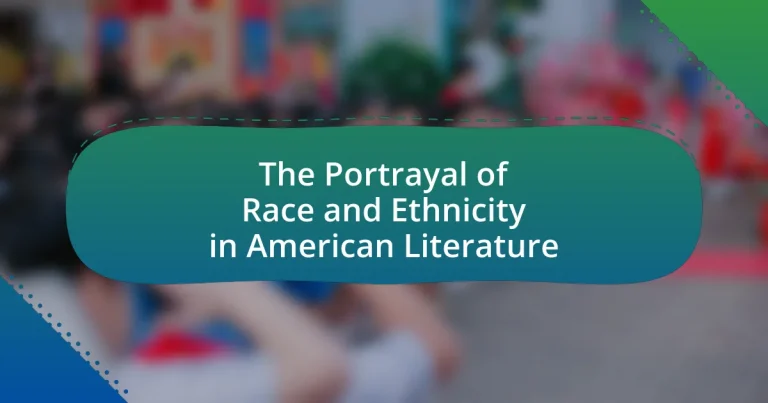The portrayal of race and ethnicity in American literature examines the intricate dynamics of social identity, power structures, and cultural narratives across various historical contexts. This article explores how literary representations have evolved from stereotypical depictions to more nuanced and authentic portrayals, influenced by significant historical events such as the Civil War and the Civil Rights Movement. It highlights key themes such as identity, oppression, and cultural heritage, while discussing the impact of diverse literary movements and contemporary authors on the understanding of race and ethnicity in society. Additionally, the article addresses the consequences of perpetuating stereotypes and the importance of literature in shaping societal perceptions and fostering empathy.

What is the Portrayal of Race and Ethnicity in American Literature?
The portrayal of race and ethnicity in American literature reflects the complexities and dynamics of social identity, power structures, and cultural narratives. American literature has historically depicted the experiences of various racial and ethnic groups, often highlighting themes of oppression, resilience, and identity formation. For instance, works by authors such as Toni Morrison and James Baldwin explore the African American experience, addressing systemic racism and the quest for self-identity. Additionally, literature from Asian American, Native American, and Latino authors provides insights into their unique cultural perspectives and struggles, contributing to a broader understanding of America’s multicultural landscape. This representation is crucial for acknowledging historical injustices and fostering empathy among diverse audiences.
How has the portrayal of race and ethnicity evolved over time in American literature?
The portrayal of race and ethnicity in American literature has evolved significantly from the early 19th century to the present day. Initially, literature often depicted racial and ethnic groups through stereotypes, reinforcing societal prejudices, as seen in works like Harriet Beecher Stowe’s “Uncle Tom’s Cabin,” which, while anti-slavery, also presented limited and often negative portrayals of Black characters.
As the 20th century progressed, authors such as Zora Neale Hurston and Langston Hughes began to challenge these stereotypes, presenting more complex and authentic representations of African American life during the Harlem Renaissance. This shift continued into the late 20th and early 21st centuries, where contemporary authors like Chimamanda Ngozi Adichie and Junot Díaz explore multicultural identities and the nuances of race and ethnicity, reflecting a broader spectrum of experiences and perspectives.
This evolution is evidenced by the increasing diversity of voices in literature, with the rise of multicultural literature that addresses intersectionality and the complexities of identity, as seen in the works of authors from various backgrounds. The changing societal attitudes towards race and ethnicity have thus been mirrored in literature, leading to richer, more varied narratives that challenge previous norms and stereotypes.
What historical events have influenced these portrayals?
The portrayal of race and ethnicity in American literature has been significantly influenced by events such as the Civil War, the Civil Rights Movement, and the Great Migration. The Civil War (1861-1865) led to the abolition of slavery and prompted authors to explore themes of freedom and identity, as seen in works like Harriet Beecher Stowe’s “Uncle Tom’s Cabin.” The Civil Rights Movement (1950s-1960s) catalyzed a wave of literature that addressed racial injustice and equality, exemplified by James Baldwin’s essays and novels. Additionally, the Great Migration (1916-1970), where millions of African Americans moved from the rural South to urban areas in the North, inspired writers like Langston Hughes and Zora Neale Hurston to depict the complexities of African American life and culture. These historical events shaped the narratives and characterizations within American literature, reflecting the evolving social landscape.
How do different literary movements reflect changes in racial and ethnic representation?
Different literary movements reflect changes in racial and ethnic representation by responding to the social, political, and cultural contexts of their times. For instance, the Harlem Renaissance in the 1920s emphasized African American culture and identity, showcasing writers like Langston Hughes and Zora Neale Hurston, who challenged prevailing stereotypes and celebrated Black heritage. Similarly, the postmodern movement in the late 20th century introduced diverse voices, including those from Latinx and Asian American communities, as seen in the works of authors like Sandra Cisneros and Maxine Hong Kingston, who explored complex identities and experiences. These movements illustrate a shift from marginalization to visibility, as literature increasingly reflects the multifaceted nature of race and ethnicity in American society.
Why is the portrayal of race and ethnicity significant in American literature?
The portrayal of race and ethnicity is significant in American literature because it reflects the complex social dynamics and historical contexts of the United States. This representation allows for the exploration of identity, power structures, and cultural narratives that shape the American experience. For instance, works like “The Color Purple” by Alice Walker and “Beloved” by Toni Morrison delve into the African American experience, highlighting the impact of slavery and systemic racism. Such literature not only provides insight into marginalized voices but also challenges dominant cultural narratives, fostering empathy and understanding among diverse audiences.
What impact does literature have on societal perceptions of race and ethnicity?
Literature significantly shapes societal perceptions of race and ethnicity by providing narratives that challenge stereotypes and promote understanding. Through diverse characters and experiences, literature can humanize marginalized groups, fostering empathy and awareness among readers. For instance, works like “To Kill a Mockingbird” by Harper Lee and “The Color Purple” by Alice Walker have highlighted racial injustices and the complexities of identity, influencing public discourse and attitudes toward race. Studies, such as those conducted by the National Endowment for the Arts, indicate that reading literature can enhance cultural awareness and reduce prejudice, demonstrating literature’s role as a catalyst for social change regarding race and ethnicity.
How do authors use their narratives to challenge or reinforce stereotypes?
Authors use their narratives to challenge or reinforce stereotypes by depicting characters and situations that either conform to or subvert societal expectations. For instance, in works like “The Help” by Kathryn Stockett, the narrative reinforces stereotypes about African American maids, while in “The Hate U Give” by Angie Thomas, the story challenges stereotypes by presenting complex, multidimensional characters who navigate issues of race and identity. These contrasting approaches illustrate how narratives can either perpetuate existing biases or promote understanding and empathy, thereby influencing readers’ perceptions of race and ethnicity in American society.

What are the key themes related to race and ethnicity in American literature?
Key themes related to race and ethnicity in American literature include identity, oppression, and cultural heritage. Identity is often explored through characters grappling with their racial or ethnic backgrounds, as seen in works like “The Joy Luck Club” by Amy Tan, which delves into the complexities of Chinese-American identity. Oppression is a recurring theme, highlighted in texts such as “Beloved” by Toni Morrison, which addresses the historical trauma of slavery and its lasting impact on African American communities. Cultural heritage is celebrated and examined in literature like “The House on Mango Street” by Sandra Cisneros, where the protagonist navigates her Mexican-American roots. These themes reflect the diverse experiences and struggles of various racial and ethnic groups in America, providing insight into the broader societal context.
How do themes of identity and belonging manifest in literary works?
Themes of identity and belonging manifest in literary works through the exploration of characters’ cultural backgrounds, personal struggles, and social contexts. For instance, in works like “The Joy Luck Club” by Amy Tan, characters navigate their Chinese heritage while seeking acceptance in American society, illustrating the tension between cultural identity and the desire for belonging. Similarly, in “Their Eyes Were Watching God” by Zora Neale Hurston, the protagonist Janie’s journey reflects her quest for self-identity and connection within her community, emphasizing the interplay between race, gender, and personal fulfillment. These narratives often highlight the complexities of identity formation in relation to societal expectations and cultural heritage, demonstrating how literature serves as a medium for understanding the multifaceted nature of belonging.
What role does cultural heritage play in shaping characters’ identities?
Cultural heritage plays a crucial role in shaping characters’ identities by providing a framework of values, beliefs, and traditions that influence their behaviors and perspectives. This framework often reflects the historical experiences and social contexts of specific racial and ethnic groups, which can lead to a deeper understanding of characters’ motivations and conflicts. For instance, in American literature, characters from diverse backgrounds often grapple with the legacies of their cultural heritage, which can manifest in their struggles for acceptance, identity, and belonging. This is evident in works like “The Joy Luck Club” by Amy Tan, where the characters’ Chinese heritage profoundly impacts their relationships and self-perception, illustrating how cultural heritage is integral to identity formation.
How do authors depict the struggles for acceptance and recognition?
Authors depict the struggles for acceptance and recognition through character development, thematic exploration, and narrative conflict. For instance, in works like “The Color Purple” by Alice Walker, characters face societal rejection due to their race and gender, illustrating the deep emotional and psychological impacts of exclusion. Similarly, in “Native Son” by Richard Wright, the protagonist’s experiences highlight systemic racism and the desperate quest for identity and validation in a prejudiced society. These narratives often employ symbolism and dialogue to convey the internal and external battles faced by marginalized individuals, emphasizing the universal desire for belonging and acknowledgment.
What are the common stereotypes associated with different racial and ethnic groups in literature?
Common stereotypes associated with different racial and ethnic groups in literature include the portrayal of African Americans as either criminals or entertainers, Native Americans as noble savages, and Asian Americans as submissive or overly studious. These stereotypes often simplify complex identities and reinforce societal biases. For instance, African American characters are frequently depicted in roles that emphasize violence or musical talent, as seen in works like “The Adventures of Huckleberry Finn” by Mark Twain, which reflects historical racial attitudes. Similarly, Native Americans are often romanticized in literature, as illustrated in James Fenimore Cooper’s “The Last of the Mohicans,” where they are portrayed as both fierce warriors and spiritual beings. Asian Americans, on the other hand, are often depicted through the lens of the “model minority” stereotype, which can be traced back to the portrayal of Chinese immigrants in the late 19th century, emphasizing their work ethic and academic success while ignoring their struggles. These literary representations contribute to the perpetuation of stereotypes in society.
How do these stereotypes affect the portrayal of characters?
Stereotypes significantly affect the portrayal of characters by limiting their complexity and reinforcing one-dimensional traits. In American literature, characters often embody societal stereotypes related to race and ethnicity, which can lead to misrepresentation and perpetuation of harmful biases. For instance, African American characters may be depicted solely as criminals or victims, while Asian characters are frequently portrayed as submissive or overly studious. This simplification not only undermines individual character development but also influences readers’ perceptions, as seen in studies that show media representations can shape societal attitudes towards different racial and ethnic groups. Consequently, these stereotypes hinder authentic representation and contribute to a skewed understanding of diverse cultures.
What are the consequences of perpetuating these stereotypes in literature?
Perpetuating stereotypes in literature leads to the reinforcement of harmful biases and misconceptions about racial and ethnic groups. This can result in the marginalization of these groups, as literature shapes societal perceptions and attitudes. For instance, studies have shown that repeated exposure to negative stereotypes in media can influence individuals’ beliefs and behaviors, contributing to systemic discrimination. Furthermore, literature that relies on stereotypes often lacks depth and authenticity, failing to represent the complexities of diverse cultures, which can perpetuate ignorance and hinder social progress.

How do different authors approach the portrayal of race and ethnicity?
Different authors approach the portrayal of race and ethnicity through varied lenses, often influenced by their cultural backgrounds and historical contexts. For instance, Toni Morrison explores the complexities of African American identity and the impact of systemic racism in her novels, using rich symbolism and character development to convey the emotional and psychological effects of race. In contrast, Jhumpa Lahiri focuses on the immigrant experience, highlighting the nuances of cultural assimilation and identity struggles faced by South Asian Americans, as seen in her short stories. Additionally, authors like Sherman Alexie address Native American identity by blending humor with poignant social commentary, revealing the challenges and resilience of Indigenous communities. These diverse approaches reflect the multifaceted nature of race and ethnicity in American literature, illustrating how personal experiences and societal issues shape narrative techniques and themes.
What techniques do authors use to convey racial and ethnic experiences?
Authors use techniques such as first-person narratives, symbolism, and cultural references to convey racial and ethnic experiences. First-person narratives allow readers to engage directly with the personal experiences of characters, fostering empathy and understanding. For example, in “The Color Purple” by Alice Walker, the protagonist’s voice provides insight into the struggles faced by African American women in the early 20th century. Symbolism often represents broader societal issues; in “The Joy Luck Club” by Amy Tan, the game of mahjong symbolizes the complexities of cultural identity and generational conflict among Chinese American women. Cultural references, including language, traditions, and historical context, ground the narrative in specific racial and ethnic experiences, as seen in “The House on Mango Street” by Sandra Cisneros, where the protagonist’s observations reflect her Latino heritage and the challenges of her environment. These techniques effectively illustrate the nuances of racial and ethnic identities in American literature.
How does the use of language and narrative style influence reader perception?
The use of language and narrative style significantly shapes reader perception by influencing emotional engagement and interpretation of themes. For instance, the choice of dialect, tone, and syntax can evoke specific cultural contexts, allowing readers to connect more deeply with characters and their experiences. In works like Zora Neale Hurston’s “Their Eyes Were Watching God,” the use of African American Vernacular English not only authenticates the characters’ identities but also immerses readers in the cultural landscape of the time, enhancing empathy and understanding. Studies show that narrative techniques, such as first-person perspectives, can create a sense of intimacy, prompting readers to align their views with those of the narrator, thereby affecting their perception of race and ethnicity in the narrative.
What role does character development play in representing diverse experiences?
Character development plays a crucial role in representing diverse experiences by allowing readers to engage with multifaceted identities and perspectives. Through well-crafted characters, literature can reflect the complexities of race and ethnicity, illustrating how individual backgrounds shape experiences and worldviews. For instance, novels like “The Joy Luck Club” by Amy Tan showcase the interplay between cultural heritage and personal identity, providing insight into the immigrant experience and generational differences. This depth of character enables readers to empathize with diverse narratives, fostering a greater understanding of societal issues related to race and ethnicity.
How do contemporary authors address race and ethnicity in their works?
Contemporary authors address race and ethnicity in their works by exploring complex identities, systemic inequalities, and cultural narratives. For instance, authors like Chimamanda Ngozi Adichie in “Americanah” examine the nuances of race and identity through the lens of immigration and cultural dislocation, highlighting the experiences of Nigerians in America. Similarly, Colson Whitehead’s “The Underground Railroad” reimagines the historical context of slavery, using magical realism to underscore the brutal realities faced by African Americans. These narratives often incorporate personal stories that reflect broader societal issues, such as racism, privilege, and intersectionality, thereby providing readers with a deeper understanding of the multifaceted nature of race and ethnicity in contemporary society.
What are some notable examples of recent literature that explores these themes?
Notable examples of recent literature that explores the themes of race and ethnicity in American literature include “The Vanishing Half” by Brit Bennett, which examines the complexities of identity and racial passing, and “Caste: The Origins of Our Discontents” by Isabel Wilkerson, which analyzes the caste system in America and its impact on race relations. Additionally, “Interior Chinatown” by Charles Yu presents a satirical take on Asian American identity and stereotypes within the context of Hollywood. These works have garnered critical acclaim and reflect contemporary discussions surrounding race and ethnicity in the United States.
How do modern narratives differ from those of earlier periods?
Modern narratives differ from those of earlier periods primarily in their emphasis on diverse perspectives and complex characterizations of race and ethnicity. Earlier narratives often relied on monolithic portrayals and stereotypes, reflecting a limited understanding of racial and ethnic identities. In contrast, contemporary narratives frequently explore intersectionality, allowing for multifaceted representations that challenge traditional norms. For instance, works by authors like Chimamanda Ngozi Adichie and Junot Díaz incorporate personal and cultural histories that highlight the nuances of identity, showcasing the impact of globalization and migration. This shift reflects broader societal changes and a growing recognition of the importance of inclusivity in literature.
What practical insights can be gained from studying the portrayal of race and ethnicity in American literature?
Studying the portrayal of race and ethnicity in American literature provides practical insights into societal attitudes, historical contexts, and cultural dynamics. This examination reveals how literature reflects and shapes perceptions of race and ethnicity, influencing public discourse and identity formation. For instance, works like “The Color Purple” by Alice Walker and “Native Son” by Richard Wright highlight systemic racism and the complexities of identity, offering readers a deeper understanding of the lived experiences of marginalized communities. Such literature serves as a historical document, illustrating the evolution of racial issues in America, and can inform contemporary discussions on race relations and social justice.
How can readers critically engage with texts to understand racial and ethnic dynamics?
Readers can critically engage with texts to understand racial and ethnic dynamics by analyzing the representation of characters, themes, and narratives within the context of historical and social frameworks. This involves examining how authors depict race and ethnicity, the power dynamics at play, and the societal implications of these portrayals. For instance, literary works such as “The Color Purple” by Alice Walker and “Native Son” by Richard Wright provide insights into the lived experiences of marginalized communities, reflecting systemic issues like racism and oppression. By contextualizing these texts within their historical periods, readers can better grasp the complexities of racial and ethnic identities and the impact of societal structures on these groups.
What strategies can educators use to teach these themes effectively?
Educators can effectively teach the themes of race and ethnicity in American literature by incorporating diverse texts that reflect various cultural perspectives. This strategy allows students to engage with authentic voices and experiences, fostering empathy and critical thinking. For instance, using works by authors such as Toni Morrison and Jhumpa Lahiri provides insight into the complexities of identity and belonging. Research indicates that exposure to diverse literature enhances students’ understanding of social issues, as highlighted in a study by the National Council of Teachers of English, which found that students who read multicultural literature demonstrated greater cultural awareness and sensitivity. Additionally, facilitating discussions and reflections on these texts encourages students to articulate their thoughts and connect literature to contemporary societal issues, reinforcing the relevance of these themes in today’s context.




